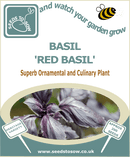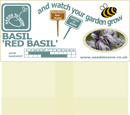Description
Red basil has the same culinary uses and flavour as Sweet Genovese Basil, but is also a superb ornamental plant with its deep purple leaves. It has pale pink flowers which are a beautiful contrast to the dark foliage and grow well in the flower bed or a container. Use as a garnish, add flavour to vinegar and oils or as adding colour to salads.
| When to sow | Sow indoors from late February, outdoors from late March to June. |
| Where to sow | Direct sow outside either thinly in rows or sparsely in pots. |
| Lightly cover seed with 1/2cm (1/4in) moist compost and keep moist, but do not overwater. | |
| Can be started off on your windowsill or propagator. | |
| If sowing early in the season outside, protect from any late frost. | |
| What to do Next | Make kitchen access easy by transplanting on into a large pot and keeping by your kitchen door. |
| If started in a pot or container transplant the complete pot rootball to avoid any root disturbance. | |
| Basil require little care once established, keep watered in dry spells and pick leaves from the plant as required. | |
| Basil plants do not like the cold therefore a warm sunny spot on a patio or windowsill is ideal. | |
| Harvest | May to October, when leaves are young. |
| Handy Tips | Although basil grows best outdoors, it can be grown indoors in a pot and, like most herbs, will do best on a sunny windowsill. |
| It should be kept away from cold drafts, and grows best in strong sunlight, therefore a greenhouse is ideal if available. | |
| Companion Planting | Basil repels the white fly and makes a good companion to tomatoes, both in the garden and in the kitchen. |
| Nutritional Information | Basil is rich in vitamins A, K and C, and magnesium, iron, potassium and calcium. |
| Serving Suggestion | Great for pesto, good for salads, or served simply with tomato and mozzarella. |
Payment & Security
Your payment information is processed securely. We do not store credit card details nor have access to your credit card information.






